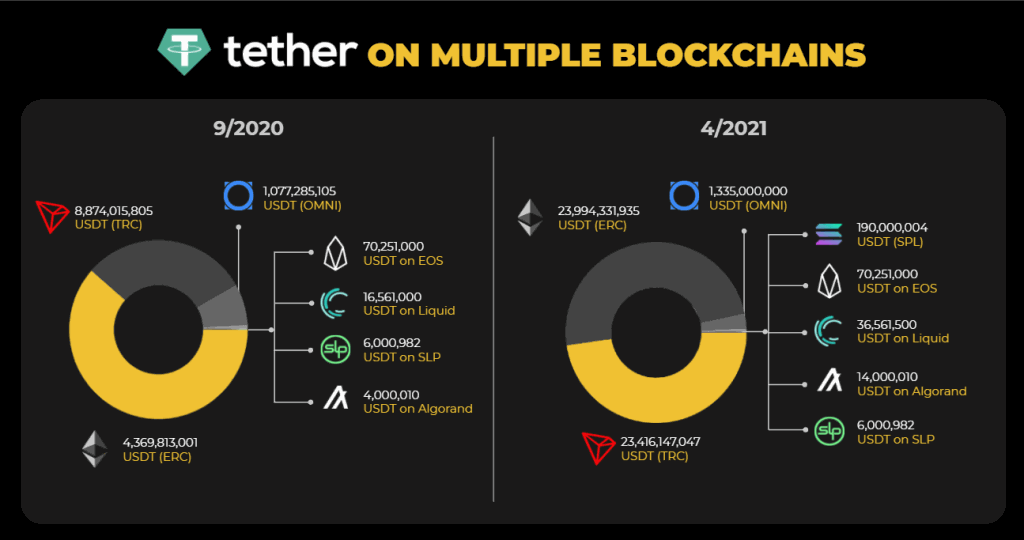In the past, you are probably still unfamiliar with the term Multi-chain, and many brothers will be confused between Multi-chain & Cross-chain. So, let’s find out What is multi-chain? Is It A Trend? And How to Invest in It.
What is multi-chain?
Multi-chain is a term that means “multi-chain, cross-platform”. More specifically, in the crypto market, if a project is deployed on a multichain, it means that the project is being deployed on at least two chains, which can be Ethereum, Binance Smart Chain, Solana, Polkadot, Avalanche or other blockchains.

Distinguish Multi-chain from Cross-chain
First, I will reiterate the Cross-chain definition.
Cross-chain is a solution to help transfer assets from one chain to another to optimize the ability to combine between chains, ie projects operating in the field of Cross-chain will have the function to help people use to connect and transfer assets in many different structured blockchain platforms.
Cross-chain helps move assets from one blockchain to another.
The difference between Multi-chain and Cross-chain is shown in the following characteristics:
Multi-chain refers to many different chains. When the “XYZ” project deploys Multichain, it means that in addition to the original chain (can be Ethereum, BSC, or another chain,…), the “XYZ” project can independently deploy in other chains like BSC or Polkadot.
However, for assets to flow between independent chains, you will need a Cross-chain tool, which is a tool that allows you to transfer assets between the Ethereum chain and other chains on the market.
Benefits and implications of Multi-chain implementation
You can see that in the current context, in the same field as AMM DEX, on each platform, there are extremely prominent names; for example, on Ethereum, there is Uniswap; on Binance Smart Chain, there is PancakeSwap; on Polygon, there is Quickswap.
However, each project operates independently and has not yet reached many users from other ecosystems. So what do you think if projects will deploy Multi-chain?
When implementing the Multi-chain mechanism on projects, not only users but the project will also enjoy the following benefits:
Reach the number of users in the new ecosystem.
Overcoming the main chain’s shortcomings (congestion, slow speed).
Take advantage of many different chains (cheap fees, fast speeds).
Popularize your token on other ecosystems (especially stablecoin projects).
Users in more miniature ecosystems can access areas their ecosystem has not implemented (Insurance, Index token,…).
Case study on Multi-chain implementation projects
With the above benefits, implementing Multi-chain is only sooner or later for projects if they want to attract users and cash flow from other ecosystems. In the following section, I will give a case study of two projects, Tether and Sushiswap, to clarify the potential of Multi-chain.
Tether
Here is an example of Tether (USDT). Tether is the most prominent stablecoin, accounting for 80% of the stablecoin market share. This is the most traded stablecoin via OTC and the coin with the most significant impact on the market through USDT “prints.”
Tether Chains Deployed
You can see Tether’s Multi-chain implementation journey through the image below. First came Bitcoin’s Omni network, Ethereum, Tron, Algorand, Solana, and EOS.
Why does Tether issue its tokens on so many chains?
Benefits with Tether
Tether is the earliest stablecoin and the most influential stablecoin in the current crypto market. Therefore, Tether certainly keeps rival stablecoins from taking its market share.
Regarding applicability, if Tether does not deploy USDT on the ERC-20 network, who will the DeFi pie – where stablecoins account for 50% of TVL worth more than $ 25 billion?
When deployed on many networks, Tether will popularize USDT for users in many different networks such as Ethereum, Polkadot, Solana, … thereby helping USDT become a widely accepted token of the project in the crypto market.
Benefits for users
In terms of experience, you will see very clearly in the deposit and withdrawal of USDT from Binance. With two different networks, just a $0.50 fee difference, users will choose the network with the cheaper fee.
As you can see, with its fast network and cheaper transaction fees, Tron has prevailed over time and surpassed Ethereum to become the network with the most USDT issues.
So after Ethereum, which blockchain network will be the next name to solve the congestion problem and ultimately become an ecosystem that can deploy DeFi projects?
I wouldn’t be surprised if it were Solana because this is one of the blockchains with good technology and the fastest growth in recent times.

Sushiswap
Sushiswap is one of the most prominent AMM DEX projects in the crypto market with a TVL of up to $4.5 billion (accounting for 7.3% of DeFi TVL market cap) and a trading volume of up to $370 million (ranked #5. in CoinMarketCap ratings).
Sushiswap Chains Will Deploy: On March 4, 2021, the Sushiswap team announced that it will deploy Multi-chain. It is specifically deployed on five chains besides Ethereum: Fantom, Polygon, xDAI, Binance Smart Chain, and Moonbeam Network. Fantom will be the first chain that Sushiswap will deploy.
Why does Sushiswap support Multi-chain? The AMM DEX field in the Ethereum ecosystem has been somewhat saturated with massive competition from Uniswap and 0x Protocol, so to be able to expand its potential and attract new users to its platform, Sushiswap needs to be deployed in other chains where there are not many prominent AMM DEX projects.
Trends and development of Cross-chain & Multi-chain
From a personal perspective, the Cross-chain tool significantly contributes to the development of Multi-chain because Cross-chain will help us transfer assets between chains. I will summarize the development of Cross-chain and Multi-chain through the following 3 stages:
Phase 1: The appearance of Cross-chain tools on the new ecosystem
In phase 1, to attract assets from other ecosystems, newly developed ecosystems such as Binance Smart Chain and Polkadot both implement a Cross-chain bridge that allows brothers to transfer assets from other chains to the chain. especially attracting users from the Ethereum chain – the chain with the most substantial development of DeFi platforms.
Binance Smart Chain also implements Binance Bridge, allowing brothers to move from another chain to the BSC chain. Not only BSC, but each ecosystem will also gradually deploy its “bridge” tool when Solana has Wormhole, NEAR has Rainbow Bridge, etc.
Bridges Rainbow Bridge, Binance Bridge and Wormhole.
I consider this to be phase 1 because most of the supporting tools are created by those ecosystems themselves, and most only focus on bringing users from Ethereum to their ecosystem.
Phase 2: Appearing projects specializing in the field of Cross-chain & Multi-chain support
By phase 2, you will see many projects specializing in cross-chain bridges for you to use. Interacting and transferring your assets to more chains on one platform will be easier.
AnySwap, Multi-chain.xyz are two prominent projects in Cross-chain Bridge; they support up to 10 chains, mainly chains built on Ethereum’s EVM. These projects help you transfer assets between many chains, such as Ethereum, BSC, Fantom, … without having to do it on many different bridges.
This will be the decisive phase before projects deploy on other chains. You should pay attention to whether the native token from the project is used a lot on the new chain. If you see tokens being used a lot in Yield Farming, Pool or AMM, then there is a high chance that the project will deploy on those chains because many users already use a Cross-chain bridge to circulate tokens.
Phase 3: Multi-chain integration becomes indispensable for the DeFi project
The market is currently between the 2nd and 3rd stages when more Cross-chain tools are born. At the same time, large and potential projects in the market are gradually implementing Multi-chain.
Once a project implements Multi-chain in the market, they are looking to reach new users and popularize their products to the market. I can partly conclude that, if successfully deployed on other chains, the projects will have higher applicability, attract more users, and bring more cash flow to the projects.
What opportunities for investors?
To get good investment opportunities, please pay attention to large projects in essential fields such as AMM DEX or Lending that have not yet implemented Multi-chain because they will be trending and potential projects. First Multi-chain implementation.
So how to predict which projects will deploy Multi-chain?
Monitor the social media activities of potential chains like Binance Smart Chain or Polkadot. Before deploying in new chains, they will develop a Cross-chain tool to help you transfer assets to those chains or have AMA conversations with the development team to announce the cooperation before. officially implemented.
Following and listing DeFi projects in many different ecosystems, you will see that some emerging ecosystems are missing essential areas, such as Lending or AMM DEX. Therefore, projects that have “matured” in the original ecosystem will tend to find a way to deploy and attract users on other chains, similar to Sushiswap.
Summary
Deploying Cross-chain & Multi-chain is only a matter of time for projects to reach new users.
Pay attention to the big projects in the Ethereum ecosystem; they are the teams with the potential to deploy on the new ecosystem.
Pay attention to projects operating in the foundational field of an ecosystem such as AMM DEX, Lending, Stablecoin or Synthetic.
Follow the social networking sites of ecosystems such as BSC, Polkadot or Solana to keep up with the projects’ AMA or Cross-chain tool information.
These ” alerts ” help you quickly search for “hidden gems” before they officially deploy Multi-chain.
These are the things that you need to notice!


